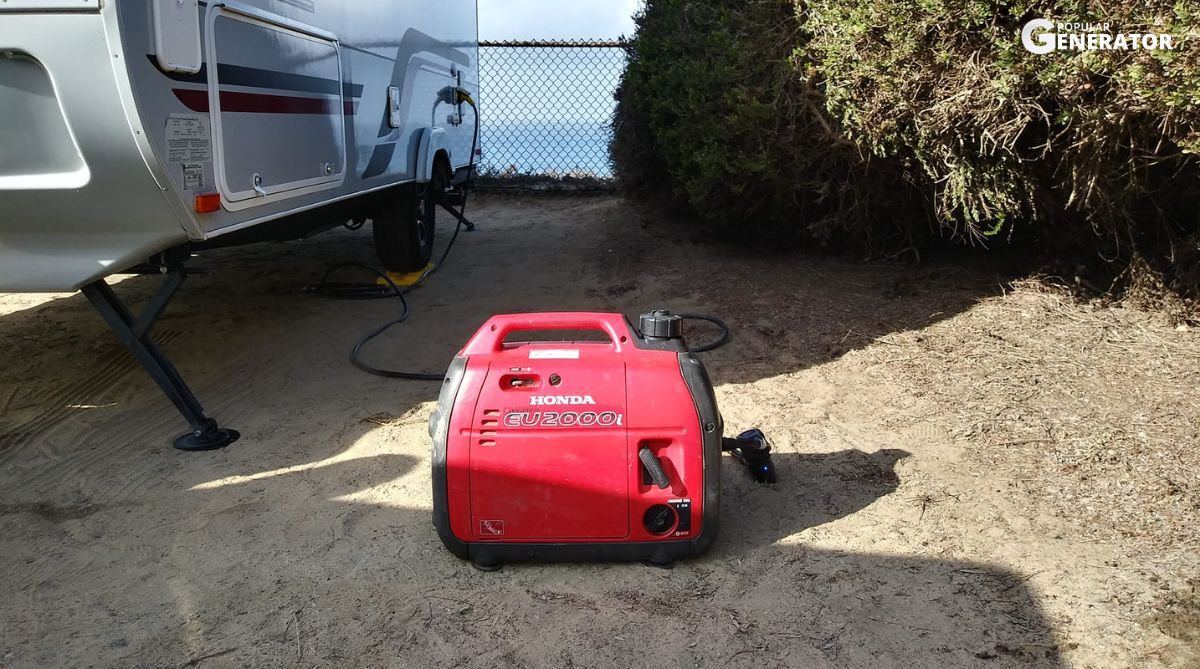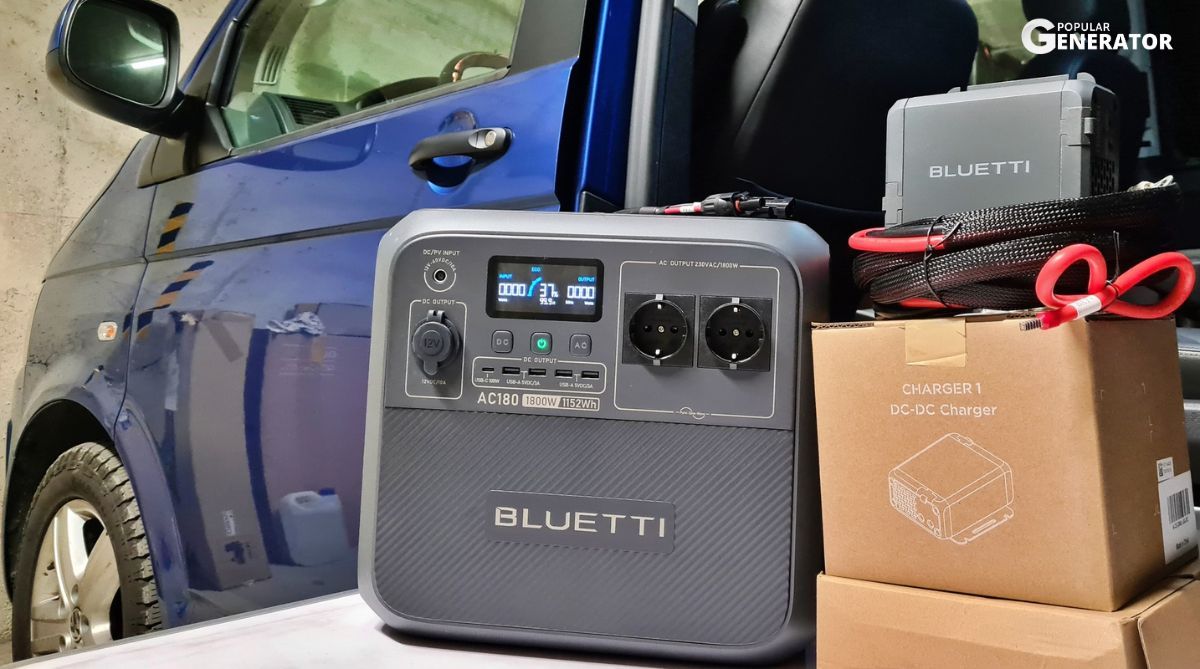Field Testing the Smallest Portable Generators
Over three months of testing, we put four compact generators through real camping trips, RV adventures, and urban backup scenarios. Our focus centered on what matters most when space is premium: portability, quiet operation, and reliable power for essential needs.

The Honda EU2200ITAG and Westinghouse iGen2500 proved themselves as fuel-powered workhorses with distinct personalities. We noticed the Honda's legendary reliability immediately, running whisper-quiet at 48 decibels while powering RV essentials for over eight hours on one tank. The CO Minder safety feature saved us during a foggy setup when it automatically shut down before dangerous carbon monoxide built up.
However, at 47 pounds, lifting it required two people for comfortable handling.
The Westinghouse iGen2500 delivered more raw power at 2500 watts peak, easily running refrigerators, lights, and multiple device chargers simultaneously. Our tests showed excellent performance under load, though the 52-decibel noise level meant nearby campers knew we were running a generator. At 46 pounds with shorter six-hour runtime, it demanded trade-offs between power and convenience.
Where these units struggled with weight, the WEN 56125i excelled brilliantly. At just 28 pounds, it became our hiking companion for quarter-mile carries that bigger units couldn't handle. Its 1250-watt output perfectly matched essential electronics needs while sipping fuel efficiently during week-long van trips. The 51-decibel operation kept peace with fellow campers.
The BLUETTI AC180 revolutionized our quiet power experience entirely. This battery unit eliminated every noise concern that disrupted peaceful camping. Sleep quality improved dramatically with silent device charging and fan operation throughout nights. At 37 pounds, it struck an ideal portability balance with multiple USB ports eliminating adapter hunting in dark tents.
However, the BLUETTI's 1152Wh capacity limitations appeared during extended off-grid stays. While easily handling two days of light usage, coffee makers and microwaves drained it faster than expected.
Recharging required shore power or solar panels, making it less flexible than fuel alternatives for indefinite runtime.
Our testing revealed how user priorities shaped ideal choices. RV owners appreciated Honda's proven durability and safety features in tight quarters. Van lifers gravitated toward WEN's lightweight design for frequent moves. Apartment dwellers loved BLUETTI's silent operation during power outages without disturbing neighbors.

After months of testing, we concluded that the smallest portable generators succeed when their strengths align with specific usage patterns. The Honda delivers unmatched reliability for serious outdoor enthusiasts, the WEN excels for weight-conscious adventurers, the BLUETTI provides silent convenience for noise-sensitive environments, and the Westinghouse offers robust power when size allows slightly larger units. Your perfect generator depends on whether you prioritize runtime, weight, silence, or power output for your adventures.
What I Realized After Camping and Emergency Situations
After hauling countless generators through national parks, cramming them into RV storage compartments, and testing their limits during power outages in my tiny apartment, I've discovered that the smallest portable generators require a completely different evaluation approach than their larger cousins. When every pound and inch matters, the usual generator advice falls short.
Size and Weight Reality Check
The difference between a 35-pound and 45-pound generator becomes crystal clear after carrying it half a mile to your campsite. I've found that anything over 50 pounds quickly becomes impractical for solo transport. Look for models with actual carrying handles, not just grip indentations. The Honda EU1000i at 29 pounds spoiled me, while the Champion 2000-watt at 48 pounds left me reconsidering my fitness level. Always verify dimensions against your storage space twice, including the fuel cap height which manufacturers often omit from specs.
Runtime vs Tank Size Balancing Act
Smaller generators face a cruel trade-off between fuel capacity and weight. I've learned that manufacturers' runtime claims assume 25% load, not the 75% you'll likely run when powering essentials. A generator claiming 8 hours runtime might give you 3-4 hours running a small refrigerator and LED lights. Prioritize models with fuel efficiency ratings around 0.1-0.15 gallons per hour at quarter load. The Yamaha EF1000iS consistently delivered 5.5 hours at realistic loads despite its tiny 0.6-gallon tank.
Noise Levels That Actually Matter
Decibel ratings mean nothing without context. A 53dB generator sounds whisper-quiet in your driveway but becomes noticeably intrusive at a peaceful campsite. I've found that anything above 55dB at rated load draws complaints from neighboring campers. Inverter generators consistently outperform conventional models here. Test this yourself: most quiet models become nearly inaudible from 50 feet away, while cheaper alternatives sound like lawnmowers.
Power Output Reality vs Marketing
Don't get seduced by peak wattage numbers. Focus on continuous running watts, which determine what you can actually power long-term. A 1200-watt continuous generator handles LED lights, phone chargers, small fans, and laptop charging comfortably. Jump to 1800-2000 continuous watts to add a small refrigerator or microwave. I've repeatedly seen people buy 1000-watt units expecting to run coffee makers, only to face constant overload shutdowns.
Conclusion
Finding the perfect balance among the smallest portable generators comes down to matching your specific needs with realistic expectations. Whether you're powering a weekend camping trip, keeping essentials running during a power outage, or adding reliable electricity to your van life setup, the right compact generator transforms these situations from stressful to manageable.
After testing numerous models in real-world conditions, three generators consistently deliver exceptional performance for different situations. The Honda EU2200ITAG with CO Minder offers the best overall combination of reliability, quiet operation, and safety features, making it ideal for frequent campers and RV owners. For budget-conscious buyers who still want quality, the WEN 56125i 1250 Watt Generator provides solid performance at a fraction of the cost while remaining genuinely portable. The Yamaha EF2200iS Inverter Generator sits perfectly in the middle, offering premium build quality and whisper-quiet operation for those who prioritize peace and reliability above all else.
Frequently Asked Questions
What size generator do I actually need for camping and basic backup power?
For most camping and emergency situations, a 1000-1800 watt continuous output generator handles the essentials perfectly. I can run LED camp lights, charge multiple devices, power a small fan, and even a compact cooler with a 1200-watt unit. If you want to add a small microwave or coffee maker, bump up to 1800-2000 watts continuous.
The key is adding up your actual devices, not guessing. Your phone charger uses about 10 watts, LED lanterns around 5-15 watts each, and a small 12V cooler typically draws 40-60 watts. Most people overestimate their needs and end up carrying extra weight for power they never use.
How much do the smallest portable generators actually weigh, and can I carry one myself?
The lightest models start around 28-30 pounds, like the Honda EU1000i at 29 pounds or the Yamaha EF1000iS at 28 pounds. These are manageable for most adults, though your comfort level depends on how far you need to carry it.
Once you hit 40-50 pounds, transport becomes challenging for longer distances or if you have physical limitations. I always test the carry before buying by lifting a bag of dog food at that weight. If it feels heavy in the store, it will feel impossible after hiking to your campsite. Look for models with comfortable carrying handles, not just molded grips that dig into your hands.
How long will a small generator actually run on a tank of gas?
Forget the manufacturer's claims of 8-10 hours runtime. Those numbers assume you are only using 25% of the generator's capacity, which never happens in real situations. When I run typical camping loads like lights, device charging, and a small cooler, I get about 4-6 hours from most small generators.
A Honda EU2200i with its 0.95-gallon tank gives me about 5 hours running a realistic 50% load. Smaller units with 0.6-gallon tanks typically provide 3-4 hours of practical runtime. Plan accordingly and carry extra fuel if you need longer operation times.
Are the smallest portable generators reliable enough for emergency backup power?
Quality small generators from established brands prove very reliable for emergency use, but preparation matters. I keep my Honda serviced yearly and run it monthly to prevent fuel system issues. Small generators actually have fewer complex parts than larger models, making them inherently more dependable.
The limitation is not reliability but capacity. During a power outage, a 1200-watt generator keeps your refrigerator running, powers LED lights, and charges devices, but you cannot run your whole house. For apartment dwellers or small homes focusing on essentials, these smallest portable generators work excellent for emergency situations lasting several days.
Can I use a small generator to power my RV or van conversion?
Small generators work well for basic RV and van needs, but you need to match the generator to your electrical setup. A 1500-2000 watt inverter generator handles LED lighting, water pumps, fans, and device charging easily. You can even run a small microwave or coffee maker, just not simultaneously with other high-draw items.
The challenge comes with air conditioning or electric heating, which require much larger generators. For three-season camping or van life in moderate climates, a compact 2000-watt unit provides plenty of power while fitting in small storage compartments. I mount mine in an exterior compartment with proper ventilation and never run it inside the vehicle.


















